Quick Wins - Stop Being a One Man Show
The 3-Step Method to Hire and Scale with VAs
Hi — I’m Damon Nelson from GeekOutFridays. If you’ve ever felt trapped running every part of your business alone, this post is for you. In a recent Quick Wins session I laid out a simple, repeatable three-step method I use to hire virtual assistants (VAs) and scale without stress. Below I’ll walk you through the exact process: how to pick the right tasks, document them so anyone can follow, and hand off the work so it runs like a machine.
Why hiring a VA is a game changer
As solopreneurs we wear a dozen hats. We try to be efficient by doing everything ourselves, but that’s a false economy. You save a little money on the surface, but you lose the opportunity to focus on revenue-generating activities. When I started delegating repetitive tasks to VAs, I multiplied my output and created lasting assets — blog posts, scheduled videos, and evergreen content — without burning myself out.
"You're the bottleneck. Every task that I do as a solopreneur passes through me." — Damon Nelson
Think of hiring a VA as turning time-sucking, low-value activities into systems that scale. The goal is not to hand off everything immediately; it’s to hand off the right work in the right way so your business grows and you reclaim your time.
Overview: The 3-step method
Here’s the framework you’ll use:
- Step 1: Identify the boring task — pick one repetitive, time-consuming task you do frequently and could teach someone to do.
- Step 2: Document the workflow — record, transcribe, and build a clear checklist and SOP for the task.
- Step 3: Hand it off — hire the VA, run a short trial, set expectations, and manage via simple tools.
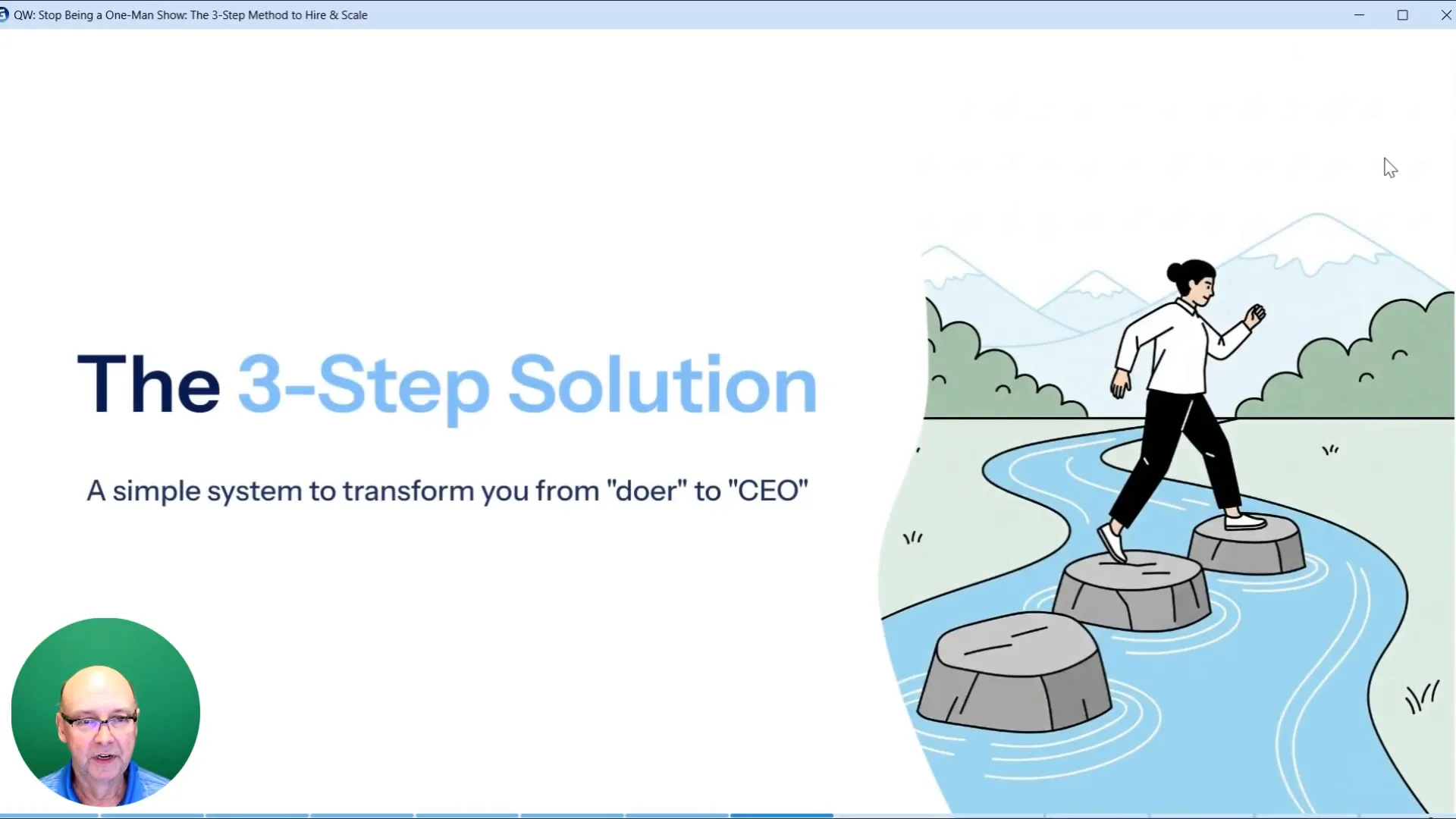
Step 1 — Identify the perfect starter task
Start small. The right starter task is repetitive, well-defined, and doesn’t require you to be ultra-creative or make judgment calls every time. Examples that work well:
- Uploading blog posts and formatting them
- Scheduling and publishing social media posts
- Formatting and sending email newsletters
- Basic video editing tasks or uploading and tagging videos
- Data entry and list building
Why start small? Because repeatable tasks can be perfected. Your first VA will probably watch your training a few times and then take a few days to ramp up. Be patient: once they hit their stride, they’ll perform like a machine and free you up to focus on growth.
How to choose
Pick a task that you do 20–30 hours a week or that eats into your creative flow. If you can describe it clearly — even if you don’t know every nuance — it’s a candidate. The trick is selecting tasks that are consistent and measurable so you can set expectations.
Step 2 — Document the workflow so anyone can follow
Documentation is the secret sauce. This is where most people get stuck, but it’s easier than you think.
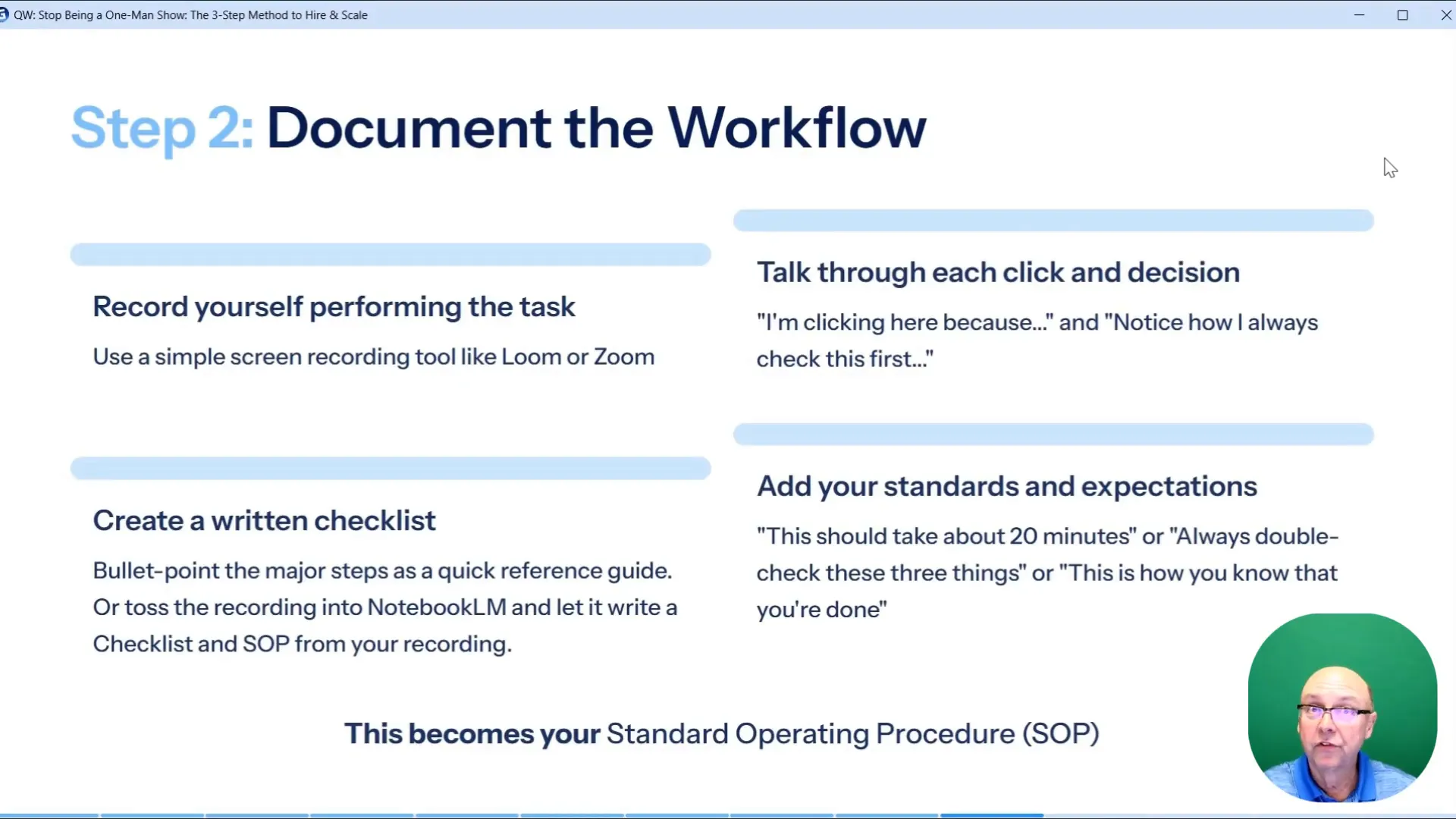
Here’s the process I use:
- Turn on screen recording (I use Zoom) and perform the task while narrating everything. Say why you click certain buttons, why you pick a specific image, or why you choose a category. Anything you think is obvious probably needs explanation.
- Keep the raw recording. Give that raw video to the VA. Many of my training videos are long — an hour to two and a half hours — and that’s okay. The details help.
- Convert the video into a checklist and an SOP. I use NotebookLM (it’s incredibly helpful), but a simple bullet-point checklist in Google Docs works just fine.
- Add standards and expectations. Tell the VA what a good day looks like (for example: “I can do 12 videos in one day; I expect you to reach 12 videos/day within two weeks; if you can't, explain why”).
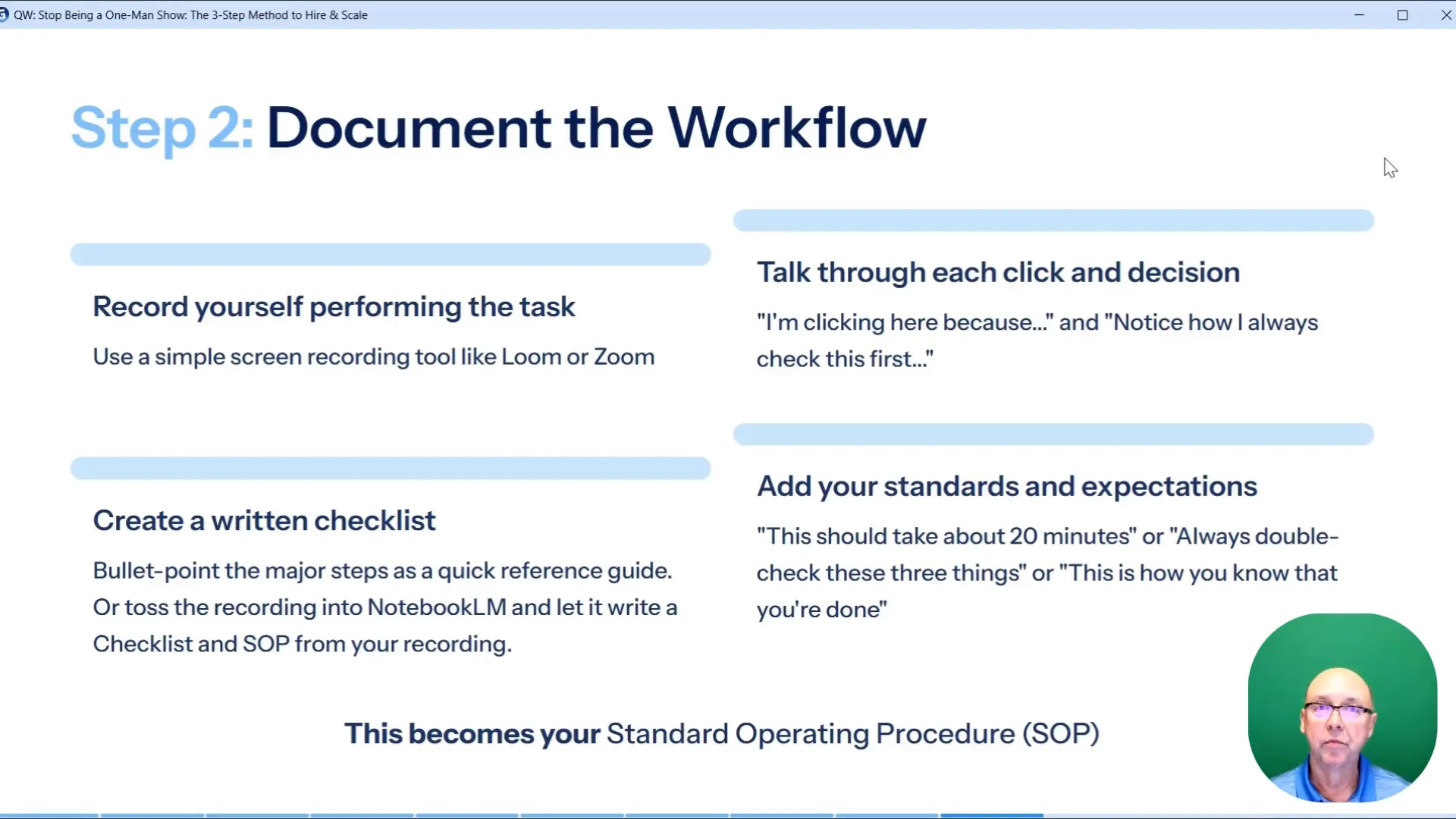
Standards are crucial. Without measurable goals, work can drift and you’ll be disappointed. Put performance expectations in writing and, if helpful, in the contract.
What to include in your SOP
- Objective: What is the task and why it matters.
- Step-by-step actions: Exact clicks, selections, and rules.
- Examples and edge cases: What to do if X occurs.
- Quality standards: Formatting rules, image sizes, tone guidelines.
- Performance goals: Daily/weekly output expectations.
- Reporting: How and when the VA communicates progress and blockers.
Step 3 — Hand it off and manage simply
Once you have your SOP, find the right VA and run a short trial. Here's how I do it.
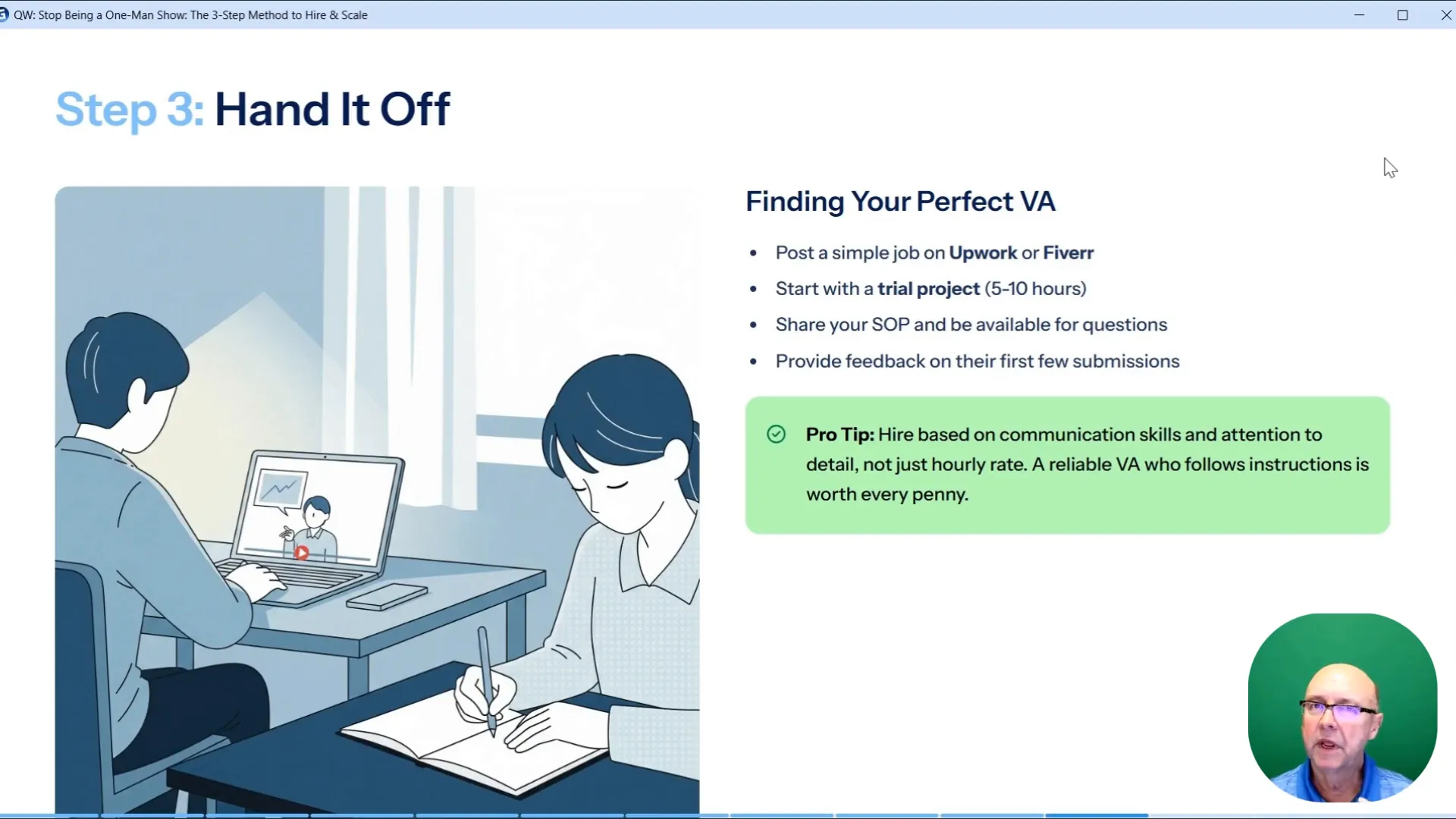
Where to find VAs
There are many platforms — try multiple sources and see what works for your needs:
- Upwork — robust but sometimes pricier
- Fiverr — good for specific gigs, but experienced freelancers may not want long-term VA roles
- Craigslist (Craigslist.ph for the Philippines) — great for steady applicants
- Regional talent — Philippines, India, Brazil, Argentina — but prioritize English-fluent candidates
- Specialized boards and services — try a few and compare results
The most important thing: hire VAs who can communicate clearly in English. Communication gaps are costly.
Trial project and onboarding
Run a small paid trial: 5–10 hours over 2–3 days. Why short? On day one they’ll likely be watching training videos and asking questions. The trial tells you:
- How quickly they learn
- Whether they follow your checklist
- How they communicate and report progress
I use Trello for day-to-day management. Create tasks with checkboxes and require a three-line daily report from the VA:
- What they accomplished today
- What they plan to accomplish tomorrow
- Any questions or blockers
This daily touchpoint takes 1–2 minutes to read and keeps you in control without micro-managing.
Compensation, contracts, and retention
Pay varies by location and skill. Here are real benchmarks I’ve used:
- Philippines: monthly full-time editors can range $500–$750 for a 40-hour workweek.
- Part-time arrangement: if a VA works two days a week (16 hours), that can cost around $60, which is about $4/hour.
- Developers or specialized coders: $10/hour or more depending on experience; long-term retention is common and valuable.
Contracts don’t need to be complicated. Provide a mini contract that outlines:
- Scope of work and deliverables
- Expected hours and schedule
- Pay rate and payment schedule
- Confidentiality expectations (consider an NDA if needed)
- Performance expectations and trial parameters
When in doubt on legal matters, consult an attorney; for day-to-day work, the important part is clarity.
Practical hiring assets: the VA handoff kit
To make this even easier, there are a few templates and assets you should prepare once and reuse:
- Fill-in-the-blank SOP/workflow template
- Mini contract template
- Job post templates for different platforms
- Interview scripts and question lists
- Onboarding checklist and reporting template
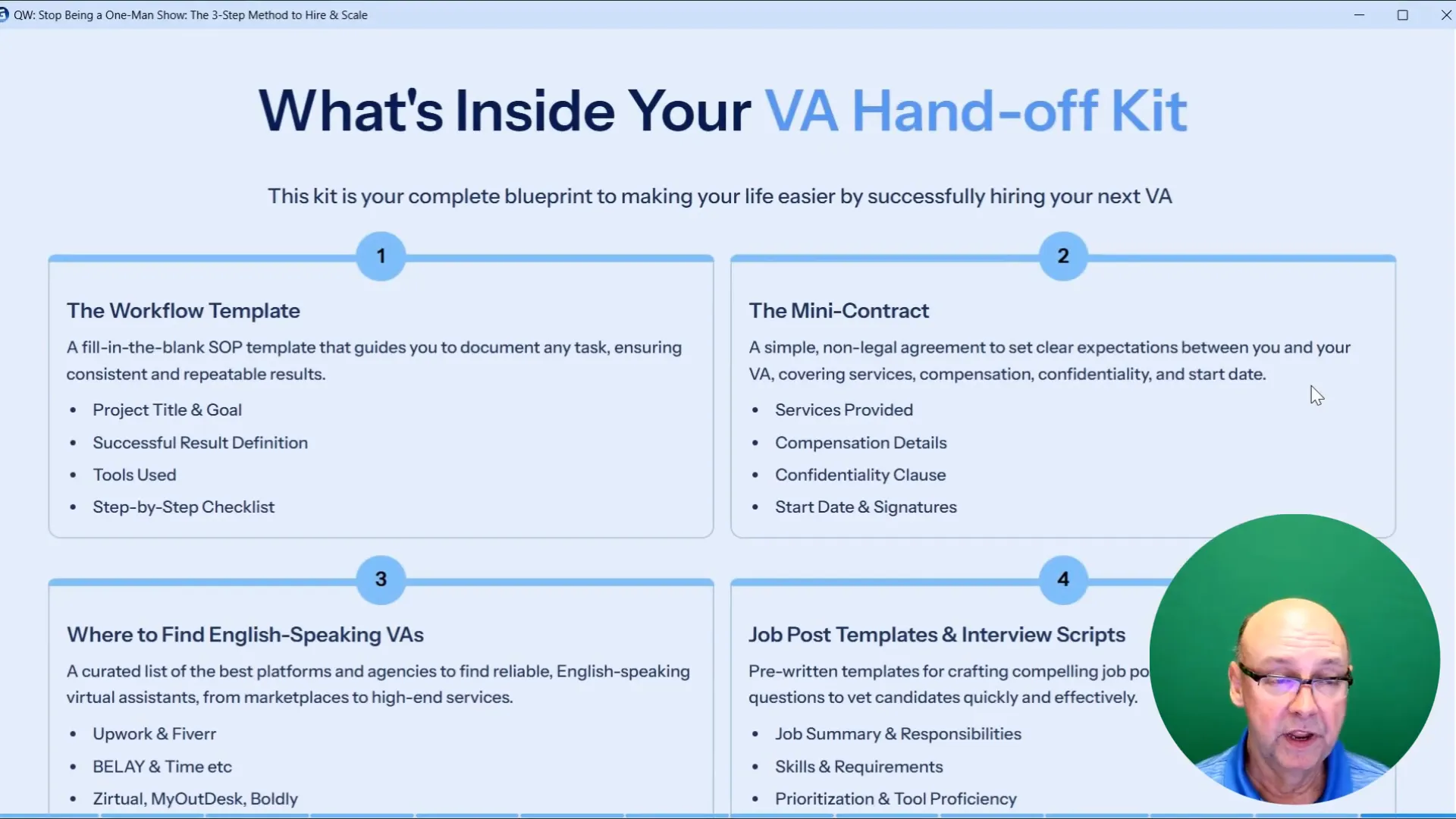
Pro tip: once you convert your screen recording to a checklist in NotebookLM, ask it to "Write me a job description for Craigslist" or "Write a job post for Fiverr." It will produce a solid draft you can tweak.
Example job post template (short)
Here’s a simple job post you can adapt:
Seeking a reliable VA to handle blog post uploading and formatting (2–3 day trial). Must be fluent in English and detail-oriented. Responsibilities: upload provided content, format headings, add images per guidelines, and schedule posts. Pay: $X/hour for trial. Please send examples of previous WordPress or CMS work.
Onboarding checklist (what to give the VA on day 1)
- Access to necessary accounts (use password manager where possible)
- Link to the raw screen-recording training
- Written SOP/checklist
- Trello board access and task list
- Expectation sheet (performance goals for 1 and 2 weeks)
First 30 days: a suggested roadmap
- Day 0–3: Trial — training, test task, and evaluation.
- Week 1: Weekly feedback call and tweak SOP based on questions.
- Week 2: Ramp up to target output; measure against expectations.
- Month 1: Decide whether to expand scope or onboard another VA for a new task.
Common fears and how to overcome them
Most people worry about two things: loss of control and the risk of someone stealing ideas. In my experience, those fears are usually unfounded. The type of repetitive work you’ll hand off isn’t glamorous — it’s process-driven. Follow these steps:
- Document everything thoroughly so the VA knows exactly what to do.
- Use short trials to test fit and communication.
- Be explicit about deliverables and reporting — clarity prevents misunderstandings.
Final checklist to get started today
- Pick one repetitive task you hate and that eats 10+ hours/week.
- Record a full walkthrough on Zoom and narrate each step.
- Create a checklist/SOP (NotebookLM or bullet points in a doc).
- Write a short job post and post it on 2–3 platforms.
- Run a 2–3 day paid trial and require a daily 2–3 line report.
- Use Trello (or similar) to track tasks and completion checkboxes.
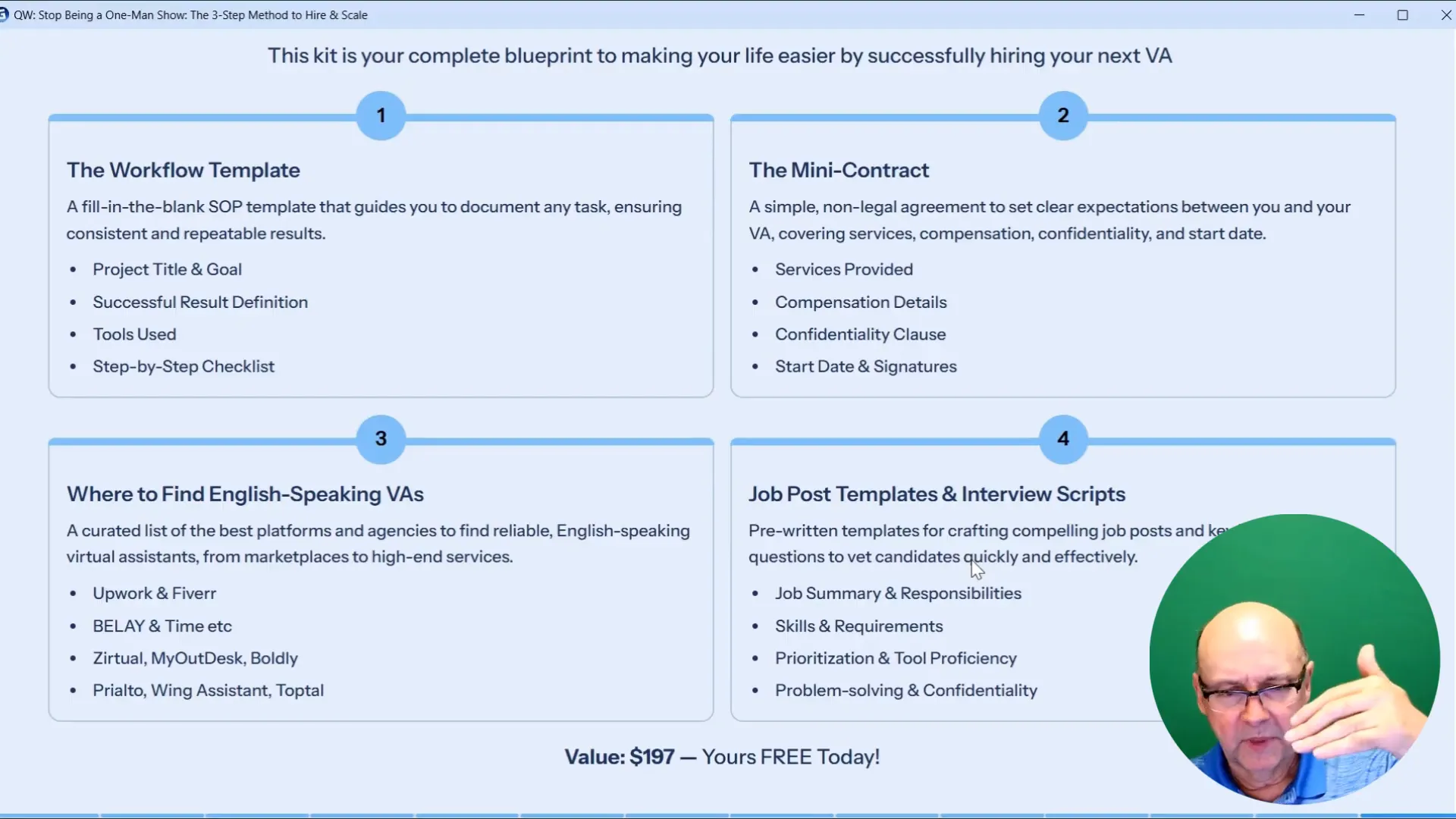
Want the VA handoff kit?
I put together a VA handoff kit that includes the SOP template, mini contract template, job post samples, and interview scripts. If you’d like it, leave a comment below and I’ll share the link. Use these tools to shorten your learning curve and get a VA working for you quickly.
Stop being the bottleneck in your business. Follow the three-step method — identify a task, document it, and hand it off — and you’ll be amazed at the momentum you create. The first hire is the hardest, but it’s also the most transformative.
— Damon Nelson, GeekOutFridays.com
Get this VA Handoff Kit
https://rssmasher.notion.site/VA-Hand-Off-Kit-How-to-Stop-Doing-All-the-Content-writing-yourself-and-start-hiring-2547123fca20802c9f19ecd3ae399e93
Plus: Where to find VAs: link the platform names in-line — Upwork, Fiverr, Craigslist. Example HTML: Upwork
If you provide the actual URLs, I can generate a final JSON mapping the exact 1–3 word anchors to each URL and optionally insert the HTML anchors directly into the blog content for you.
Want to Rewrite URLs with AI |
|
Check out this New Chrome Extension in AIMasher |
| Watch this Video |